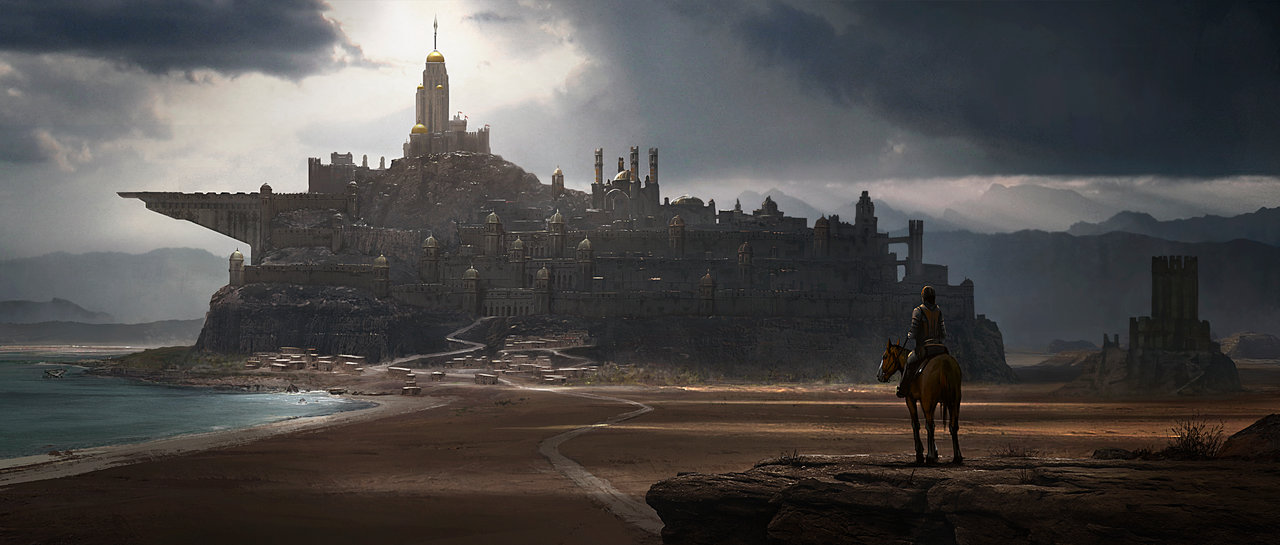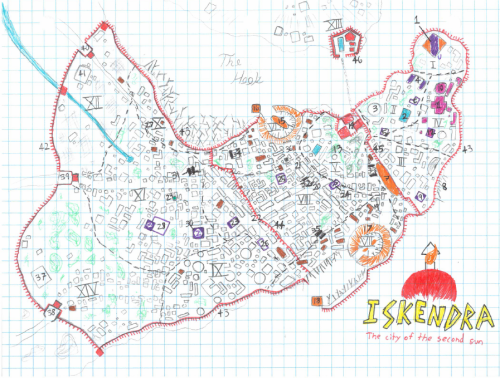Iskendra
"They call it the City, for all others seem like hamlets in her shadow"
Demographics
Racial makeup:
- Humans: ~50%
- Half-elves: ~22%
- High Folk (Palladian high elves, aasimar, genasi): ~10%
- Dragonborn: ~9%
- Tieflings: ~4%
- Other: ~5%
Government
In the Palladian state, the emperor was the sole and absolute ruler, and his power was regarded as having divine origin. Once, a Senate acted as the legislative body for the government, but in the current Era, senators have ceased to have real political and legislative authority and are now regarded as an honorary council with titular members. Their influence comes now more from their high birth or from their wealth than from being elected officials. As the Palladian Empire crumbled, the state's power was consolidated in Iskendra with most of the remaining territory divided into themes or districts each run by a strategos. Unlike previous civil governors, the strategoi answer directly to the emperor and have complete jurisdiction over both civil and military affairs. Essentially, they are the Palladian equivalent of feudal lords.
Defences
The city is surrounded four walls: the Old Walls, the Tidebreakers, the Great Cliffs of Palyponia, and the Golden Gates.
The Old Walls
- These walls cut through the center of the city and run along the edge of the Scholar’s Quarter and the Cothon harbors.
- While they date back almost one thousand years, they have never been breached by any army on land. It is said that when the keystone that holds the Old Gate falls, the city itself will fall into ruin.
- As such, the Old Walls are often adorned in times of war and unrest with religious icons and passages from the Heavenly Codex, in an effort to shore up the city’s spiritual defenses.
- Most of the city’s elites live within the Old Walls while almost all of the city’s working class lives outside of them.
- A series of whitewashed walls built two centuries ago to encompass the entire shoreline of the city.
- They stand fifteen meters high and have domed parapets spaced every hundred meters with space for two men to sit comfortably and watch.
- A ballista mount can be found in many of these parapets though in times of peace they rarely have the heavy ammunition needed to make them effective.
- The only gaps in the walls are at the city’s various harbors.
- The newest set of walls was built less than a century ago during the reign of the great Empress Palyponia II. They were built over the previous earthen fortifications when the peninsula was being threatened by the centaur hordes of Atamanik.
- They stand twenty meters high and have an earthen moat in front of them another ten meters deep. The bottom of the earthen moat is covered in tar, which can be lit to form a river of fire.
- There are three gaps in the walls—the fabled Triple Gates of Iskendra.
- They are not called the Triple Gates because there are three of these gatehouses but rather because they have three parts to each gate
Industry & Trade
Imports: grain, foodstuffs, woolen textiles, silk, dye, exotic animals, iron, gold, silver, timber, beer
Exports: capital, finished goods, tin, copper, bronze, stone, horses, skilled workers, wine
Manufacturing: ceramics, books, cookware, metalware, weapons, tools, magical items, holy artifacts, textiles
With three massive harbor districts and a strategic location between Auloa, Nioa, and the further afield realms of Iroa and Hakoa, it is no wonder Iskendra is the largest port in the world. It is said that anything a man desires can be found in its Agora Promenade—even those thing which he doesn't. However, because of Iskendra's isolation from natural resources, much of its wealth comes from importing raw materials and refining them into pieces which can be sold back to the places they came from for a profit. Iskendra's most famous industries are its publishing houses, luxury ceramics, and the export of knowledge, skilled workers, religious scholarship, and entertainment.
Infrastructure
New arrivals to the city first take note of the city's most famous landmark, the Sunspire: a massive lighthouse and holy tower dedicated to the sun god Uriah that stands at the tip of the island. Two great, covered harbors, known as cothons serve the city's mercantile class. A third harbor, the Skygate, is the city's only airship dock and one of the only a handful of airship docks in the world. The city's water is pumped through aquaducts and gathered in a central repository called the Sunken Palace. The city's second most famous landmarks are a pair of large bronze statues that stand outside each of the cothons. Each statue depicts one of Iskendra's two mythical founders Kananes and Kóreni.
Guilds and Factions
The Kyprinoi
- Sometimes derisively called the Carps or the Fishheads, the Kyprinoi are the de facto security force or city guards of Iskendra.
- This is because their bronze scale armor is decorated to look like a carp’s scales and their helms are covered to look like the head of a fish.
- Originally a mercenary company, now the Carps have been hired out indefinitely to serve as the city’s police force.
- They number around 1,300 individuals, though less than half are armed and ready at any given time.
- The Emperor is not guarded by the Aqua Corps but orders them around through an intermediary, the Master of Swords.
- An independent security force made up entirely of Varskogan warriors, these officers patrol the palace and serve as the emperor's personal guard.
- They are paid to be loyal not to the state as a whole but to the emperor and his family alone. Many emperors have fallen to coups or uprisings supported by the military or city guards and so a private force of Varangians now is considered more trustworthy than the state's own levies.
- They number around two hundred individuals.
- The Golds are supportive of and supported by the Magistrate Party, a old guard faction that believes that those of high birth should have a greater say in politics because of their blood's supposed ties to the divine founders of the Palladian Empire. The Magistrates were the de jure political entity for the Palladian Empire for much of its golden age. However, with the fall of the Empire and the growing dilution of the ranks of the nobility, the influence of the Magistrate Party has waned to the point that they are now frequently challenged by the other factions.
- The Reds are supported by and supportive of the Young Reds, a newer political faction which espouses the belief that those with greater wealth should have a greater say in politics because of their importance to the state's economy. The Young Reds have only been an entity for a few centuries but as merchants and nouveau rich citizens gain power and influence, the number Young Reds and their supporters has only grown.
- The Mirage is a shadowy criminal network native to Iskendra that operates throughout Nioa.
- Rarely spoken of in public, the Mirage has existed in the city for as long as anyone can remember. Their motives are as secretive as their agents and though the Imperial family has called them a plague on the city for centuries, few if any emperors have ever publicly moved against them.
- During the Sundering Arcana, the organization formally established residence within the abandoned Tzykanerion Palace.
- Few know the true name of the Mirage’s leader but she is said to be a woman of exceptional beauty who hails from Old Temekan in the Niru River Valley.
- Mirage agents, when rarely caught, are usually connected to the sale and distribution of nefarious or illegal magical items. They also sometimes provide shelter to known criminals or blasphemers, and have been accused of drug trafficking, money laundering, bet-fixing, price gouging, extortion, bribery, slavery, arms dealing, fraud, and assassination.
- Operating out of the Strategion, the Legion of Kanesh is the last remaining Legion of the Palladian Empire.
- It is split into several themes, each of which is responsible for the security of a specific region within Kanesh. These themes are led by a Decurion, who usually hails from a wealthy family who owns substantial property within that theme.
- The Legion of Kanesh is famed for its discipline and its ability to execute complex maneuvers. However, due to the size of the armies it usually faces, the Legion is a defensive force. They rarely meet their foes in open combat, instead allowing them to grow fat on plunder and then surprise them in ambushes from fortified locations.
- This has earned the military a grim reputation among the people but given the divisive hatred for Qartagonian raiders among the rural population, the Legion is almost always seen as the lesser evil.
Architecture
Most buildings in Iskendra are comprised of plaster stucco walls, timber frames, and terracotta tiled roofs. Poorer buildings often have thatched roofs, while the wealthy have stone foundations and flooring. Much of the architectural plans for the poor are cramped and designed to accommodate the most possible people in the smallest possible space. Because of this, and the materials used to make these tenements, the poor districts of Iskendra are particularly prone to fire. Wealthier citizens live either in multi-storied manors close to the Palatine Hill and the centers of government, or near the outskirts of the city in large estates surrounded by gardens and courtyards.
Geography
Iskendra is built upon a spit of land that extends off the southern tip of the Kaneshite peninsula. A second, more narrow spit of land called the Hook sits parallel to Iskendra forming a strait, Hook's Bay. The southeastern most tip of Iskendra rises more than seventy meters from the sea. It is upon this bluff that the city's iconic Sunspire stands, giving a stunning view of the city and the surrounding Sea of Brass. From the bluff, the land slowly descends with five hillocks each growing smaller as one moves away from the great Palatine Hill. The rest of the peninsula is a coastal plain dotted with small knolls and copses of temperate trees before it rises once more in the heart of Kanesh to form the rugged high country the region is famous for.
Natural Resources
Because of Iskendra's isolated location at the tip of the Kaneshite peninsula, the city has few natural resources within its walls. The earth is fertile but quite dry as it relies almost entirely on rainfall for natural irrigation. The outskirts of the city have fields of cereals and small orchards owned by wealthy families or the Imperial state. The ocean and strait are filled with fish, mollusks, and crabs but this alone cannot feed the million hungry mouths that call Iskendra home. Much of the city's foodstuffs comes either from the large ranches in the Kanesh highlands or the coastal fields of the Sickle Islands.
Alternative Name(s)
The City; The Radiant City; The Radiant City Eternal;
Type
Capital
Population
1,300,000
Inhabitant Demonym
Iskendran
Location under
Included Locations
Owner/Ruler
Owning Organization



Comments